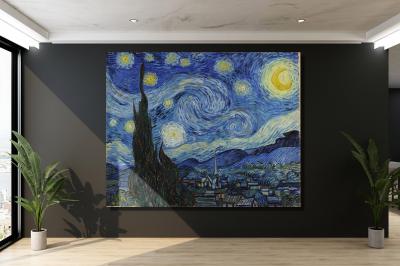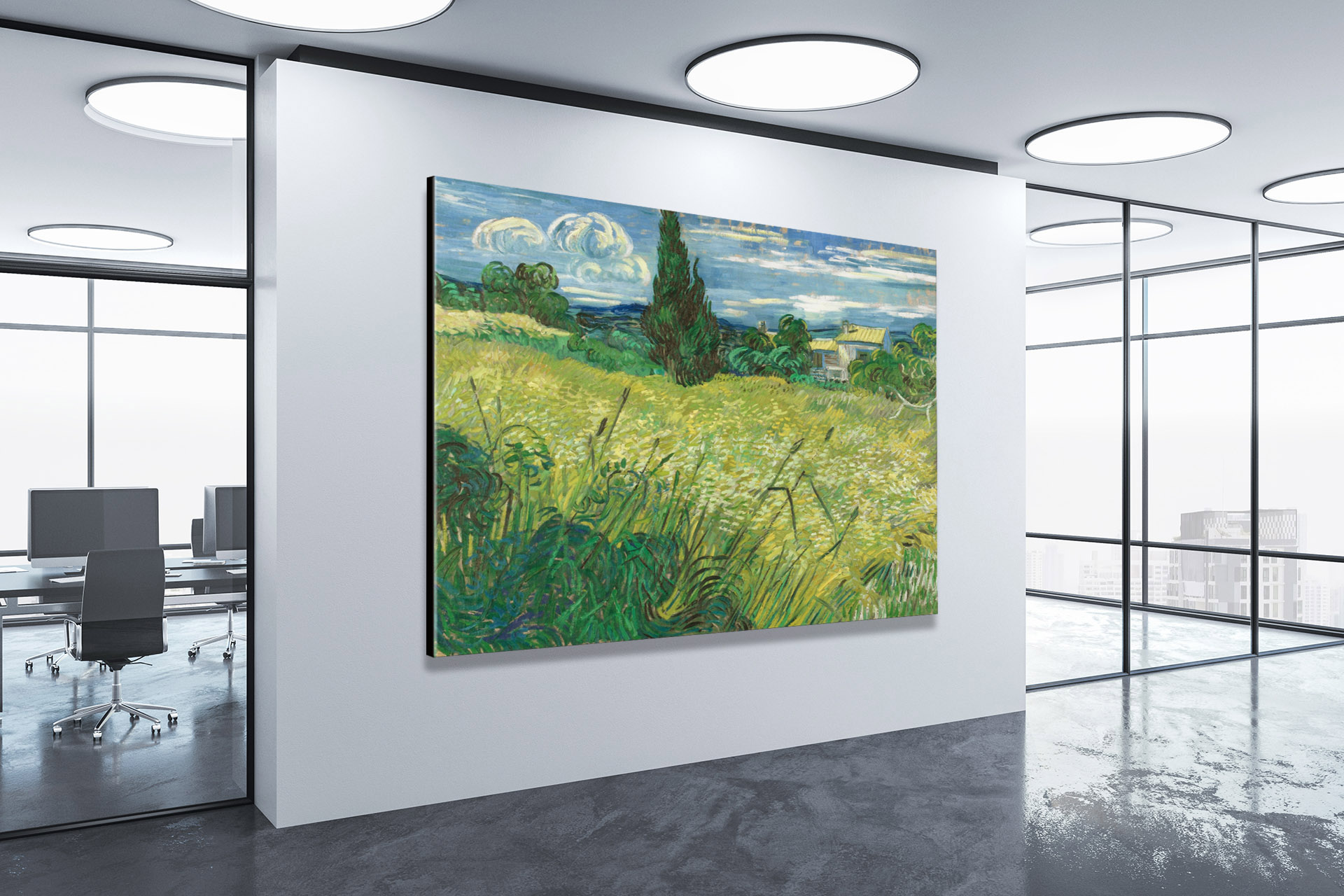Green Wheat Field with Cypress
By Vincent van Gogh, 1889
Eternal Serenity: Unlocking the Mysteries of Vincent van Gogh’s “Green Wheat Field with Cypress
In the realm of art history, few names resonate as profoundly as Vincent van Gogh. His tumultuous life and passionate dedication to his craft culminated in a body of work that continues to captivate and inspire generations of art enthusiasts. Among his many masterpieces, “Green Wheat Field with Cypress” confirms his genius, offering viewers an enchanting glimpse into the inner workings of the artist’s mind.
The Unveiling of “Green Wheat Field with Cypress”
Vincent van Gogh painted “Green Wheat Field with Cypress” in June 1889 during his stay at the Saint-Paul-de-Mausole asylum in Saint-Rémy-de-Provence, France. The painting is a mesmerizing fusion of nature’s beauty and the artist’s complex emotions. It showcases a vibrant wheat field stretching endlessly toward the horizon, with the towering cypress tree standing as a sentinel, its dark silhouette cutting through the azure sky.
“Green Wheat Field with Cypress” Large Canvas Prints from WhiteClouds
The Dance of Colors
One cannot help but be immediately drawn to the astonishing array of colors in this masterpiece. Van Gogh, a pioneer of the Post-Impressionist movement, wielded colors with unparalleled intensity. In “Green Wheat Field with Cypress,” he employs a rich spectrum of greens, yellows, and blues to breathe life into the canvas. The wheat field itself is a radiant tapestry of golden hues, as if the sun itself had bestowed its tender caress upon it. Against this luminous backdrop, the cypress tree and the sky above are painted in deep, swirling blues and greens, invoking a sense of profound depth and drama.
The Play of Light and Shadow
Van Gogh was a maestro at capturing the ethereal interplay of light and shadow. In this painting, he flexes his artistic muscles brilliantly. Sunlight bathes the scene, casting long, sinuous shadows across the field, creating a dynamic sense of movement and depth. The cypress tree, with its distinctive, dark silhouette, serves as a stark contrast to the bright, effervescent wheat field, accentuating the dichotomy of nature’s splendor and the artist’s inner turbulence.
The Cypress Tree: A Symbolic Presence
The cypress tree that graces “Green Wheat Field with Cypress” is not a mere botanical element but a powerful symbol. In van Gogh’s own words, cypresses embodied “the darkness within himself.” The tree’s towering, twisting form seems to yearn for the heavens, hinting at the artist’s aspiration for a profound connection with the divine. Simultaneously, its gnarled branches and somber presence evoke a sense of melancholy and isolation, reflecting van Gogh’s internal struggles.
Technical Triumphs and Challenges
Behind the canvas, Vincent van Gogh’s creation of “Green Wheat Field with Cypress” was a labor of love fraught with technical challenges. His unorthodox brushwork, characterized by bold, impasto strokes, presented a unique set of challenges. The heavy impasto technique required van Gogh to layer the paint thickly, achieving a textured effect that added depth and intensity to the composition. However, this approach made the drying process longer and often caused cracking, which posed a persistent obstacle for the artist.
The Location and Its Significance
Saint-Rémy-de-Provence, the picturesque town in which van Gogh created this masterpiece, played a pivotal role in shaping the artist’s perception of the world. The serene landscapes, vibrant colors, and brilliant Mediterranean light of this region left an indelible mark on his work. The cypress tree, which prominently features in many of van Gogh’s works during his stay at the asylum, was a prominent feature of the Provençal landscape, offering a striking contrast to the expansive fields of wheat.
Vincent van Gogh: The Tormented Genius
Vincent van Gogh, born on March 30, 1853, in Groot-Zundert, Netherlands, embarked on his artistic journey with unbridled passion. Yet, his life was marked by emotional turbulence, mental instability, and a relentless pursuit of artistic excellence. Van Gogh’s career as an artist was relatively brief, spanning just over a decade, but in that time, he produced an astounding body of work, including over 2,000 paintings, drawings, and sketches.
Throughout his life, van Gogh grappled with mental illness, which at times consumed him with despair. Despite these struggles, his work bore the indelible mark of his unwavering commitment to his craft. His artistic style evolved over the years, from dark, somber works to the vibrant, colorful masterpieces that would later define his legacy. Today, van Gogh is celebrated not only for his artistic genius but also for his ability to convey the depth of human emotion and the beauty of the world around us.
 Green Wheat Field with Cypress by Vincent van Gogh
Green Wheat Field with Cypress by Vincent van Gogh
Conclusion
“Green Wheat Field with Cypress” by Vincent van Gogh is a visual symphony that transcends time and place. It extends an invitation to step into the artist’s realm, to bask in the warmth of the sun, hear the whispering secrets of the wheat, and contemplate the silent wisdom of the cypress tree. This masterpiece resonates on both an emotional and intellectual level, exemplifying the enduring power of art to convey the essence of the human experience.
Van Gogh’s genius is not confined to technical prowess alone; it is his capacity to infuse his creations with profound emotion and meaning that elevates “Green Wheat Field with Cypress” to a timeless masterpiece destined to captivate and inspire generations for centuries to come. The painting’s location in Saint-Rémy-de-Provence and the technical challenges faced during its creation further deepen the layers of intrigue surrounding this iconic work of art.
Frequently Asked Questions About “Green Wheat Field with Cypress”
1. What is the significance of the cypress tree in “Green Wheat Field with Cypress”? The cypress tree is believed to symbolize several things, including van Gogh’s inner turmoil, his longing for spiritual connection, and his fascination with nature’s beauty and darkness.
2. Why did Vincent van Gogh paint so many cypress trees in his works during his stay at the Saint-Paul-de-Mausole asylum? The cypress trees in the asylum’s surroundings likely inspired van Gogh. They served as subjects for him to explore his emotions and artistic expression.
3. What inspired the vibrant and intense colors in the painting, particularly the golden wheat fields and swirling blues and greens? The colors reflect van Gogh’s emotional intensity and desire to convey his inner world through his art, which is characteristic of his Post-Impressionist style.
4. Can you explain the technical challenges van Gogh faced while creating “Green Wheat Field with Cypress”? Van Gogh’s impasto technique, using thick layers of paint, extended drying times and could result in paint surface cracking.
5. What is the historical and geographical context of the location where van Gogh painted this masterpiece? The painting was created in Saint-Rémy-de-Provence, France, where the surrounding landscapes and Mediterranean light significantly influenced van Gogh’s work.
6. How did van Gogh’s emotional and mental state influence the creation of this artwork? His struggles with mental illness and a search for solace and inspiration in nature are reflected in the painting’s emotional intensity and symbolism.
7. What is the symbolism behind the cypress tree and its representation of the “darkness within himself” in van Gogh’s words? The cypress tree symbolizes both aspiration and darkness, embodying van Gogh’s desire for a profound connection with the divine alongside his inner turmoil.
8. Are there any hidden meanings or personal messages conveyed through this painting? While there are no hidden messages, the painting is widely interpreted as a reflection of van Gogh’s emotional and psychological struggles during his time in the asylum.
9. What is the current location and condition of “Green Wheat Field with Cypress”? The painting is housed in the National Gallery in London and remains in good condition, attracting visitors worldwide.
10. How does this painting fit into the broader body of Vincent van Gogh’s work and artistic evolution? It represents van Gogh’s artistic evolution, showcasing his transition from earlier, somber works to the vibrant and emotionally charged style of his later paintings.
11. Are there any specific art movements or styles that “Green Wheat Field with Cypress” is associated with? The painting is associated with Post-Impressionism and Neo-Impressionism due to its bold use of color and unique brushwork.
12. What is the historical significance of this painting in the context of van Gogh’s career and the art world of the late 19th century? During a time when van Gogh’s work was not widely recognized, this painting exemplifies his ability to convey emotions through art.
13. How has “Green Wheat Field with Cypress” influenced later artists or art movements? It has had a lasting impact on the world of landscape painting and influenced artists exploring color and emotion in their work.
14. Are there any controversies or debates surrounding the authenticity or provenance of this artwork? No, it is widely accepted as a genuine van Gogh painting with no known controversies.
15. Can you provide insights into the emotional and psychological impact of this painting on viewers? The painting’s vibrant colors and emotional depth invite contemplation and introspection, evoking a profound response from viewers.
16. Are there any notable exhibitions or museums where “Green Wheat Field with Cypress” has been featured? The painting has been featured in various exhibitions and museums worldwide, making it accessible to a broad audience.
17. How has this painting been interpreted or analyzed by art historians and scholars over the years? Scholars have explored various aspects, including its symbolism, van Gogh’s mental state, and its place in art history, offering diverse interpretations.
18. What is the estimated value or market significance of “Green Wheat Field with Cypress” in today’s art market? While its estimated value is significant, its true worth is considered immeasurable due to its historical and artistic importance.
19. Are there any interesting anecdotes or stories related to the creation of this painting or its reception by the public and critics? One interesting anecdote is van Gogh’s struggle with strong mistral winds while painting outdoors in Saint-Rémy.
20. How can one appreciate the intricate details and nuances of “Green Wheat Field with Cypress” when viewing it in person? Close examination allows viewers to see the thick impasto texture, vibrant colors, and brushwork that reveal the depth of van Gogh’s artistic vision.
Other Articles on Vincent van Gogh Paintings
At Eternities Gate by Vincent Van Gogh, 1890
Blossoming Almond Tree by Vincent Van Gogh, 1890
Cafe Terrace at Night by Vincent Van Gogh, 1888
Daubigneys Garden by Vincent Van Gogh, 1890
Green Wheat Field with Cypress by Vincent Van Gogh, 1889
Houses at Auvers by Vincent Van Gogh, 1890
Irises by Vincent Van Gogh, 1889
Night Café by Vincent Van Gogh, 1888
Portrait of Dr. Gachet by Vincent Van Gogh, 1890
Red Vineyards by Vincent Van Gogh, 1888
Road with Cypress and Star by Vincent Van Gogh, 1890
Starry Night by Vincent Van Gogh, 1889
Starry Night over the Rhone by Vincent Van Gogh, 1888
Sunflowers by Vincent Van Gogh, 1887
The Bedroom by Vincent Van Gogh, 1888
The Church at Aurers by Vincent Van Gogh, 1890
The Garden of the Asylum by Vincent Van Gogh, 1889
The Mulberry Tree by Vincent Van Gogh, 1889
The Potato Eaters by Vincent Van Gogh, 1885
The Yellow House by Vincent Van Gogh, 1888
Tree Roots by Vincent Van Gogh, 1890
Van Gogh Self Portrait by Vincent Van Gogh, 1887
Vase with Red Poppies by Vincent Van Gogh, 1886
View of Arles by Vincent Van Gogh, 1889
Wheat Field with Crows by Vincent Van Gogh, 1890
Wheat Field with Cypresses by Vincent Van Gogh, 1889
More WhiteClouds Videos
Contact us today to learn more about our 3D services and how we can help you achieve your goals.

